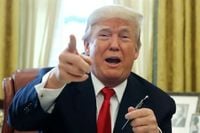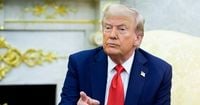In a move that’s already sending ripples through global markets, President Donald Trump has finalized a sweeping trade agreement with Japan, locking in a 15% tariff on most Japanese goods and securing a $550 billion investment pledge from Tokyo. The deal, formalized by executive order on September 4, 2025, comes after months of tense negotiations and reflects the Trump administration’s hard-nosed “America First” approach to international commerce, according to reports from Financial Times, Bloomberg, and Growth Energy.
At its heart, the arrangement is both carrot and stick. Japan, the world’s fourth-largest economy, has been given 45 days to channel $550 billion into U.S. projects selected by President Trump himself—or face the return of steep, 25% tariffs on its exports. The pressure is real: the 15% tariff, already retroactive to shipments from August 7, will jump back to 25% if Japan misses the deadline. An investment committee chaired by U.S. Commerce Secretary Howard Lutnick will present options, but Trump holds the final say on which American projects will receive the Japanese capital.
“This is historic in that Japan has committed $550 billion to the president of the United States for him to invest in the infrastructure of the national and economic security of the United States,” Lutnick said at the signing ceremony, as reported by Bloomberg. “Additionally, Japan has worked closely with us to expand access to their markets for America, and we are, we are really just thrilled to be doing it together.”
The financial structure of the deal tilts heavily in Washington’s favor. Profits generated from the Japanese investment will be split evenly between the two countries until Japan’s initial outlay is repaid. After that, the U.S. will claim a whopping 90% of all future proceeds, according to an unpublished memorandum seen by Financial Times. This is not your average trade pact; it’s a template that’s already being echoed in deals with other U.S. allies, including South Korea and the European Union, both of which have promised large investments in exchange for tariff protections.
The stakes for Japan couldn’t be higher. The 15% tariff covers most Japanese products, including automobiles and parts—a sector crucial to Japan’s economy. Relief for aerospace and automobile imports will become effective within seven days of the order, providing some breathing room for Japanese manufacturers. The U.S. will also lift certain tariffs on aircraft, aircraft parts, and generic pharmaceuticals. Not surprisingly, Japanese auto shares surged in Tokyo following the announcement: Mazda Motor Corp. and Nissan Motor Corp., both of which generate over half their revenues in North America, saw their stocks climb more than 5%, while Toyota Motor Corp. rose as much as 3.5%, Bloomberg noted.
Japanese Prime Minister Shigeru Ishiba, under pressure from rivals at home after a disappointing July election, welcomed the deal as a step toward stability. “Tariff negotiations between Japan and the United States was the top priority for the government and we have put all our effort into achieving an agreement in a best possible way as soon as possible,” Ishiba said Friday, as quoted by Bloomberg. “The way it was achieved ... is just excellent.” Ishiba sent a letter with top trade negotiator Ryosei Akazawa, expressing his hope to usher in “a golden era of Japan-U.S. relations” and inviting Trump to visit Japan.
Beyond the headline tariffs and investment, the agreement contains major agricultural provisions. Tokyo has agreed to ramp up its purchases of U.S. rice by 75% and buy $8 billion worth of American agricultural products annually, according to Quartz. This is welcome news for American farmers, who have faced years of uncertainty amid shifting global trade winds. The biofuels sector, too, stands to gain: in 2024, the U.S. exported 129 million gallons of ethanol to Japan, mostly as ethyl tert-butyl ether (ETBE). Through July 2025, exports had already reached 82 million gallons—set to surpass the previous year’s total, even before the new trade deal takes effect, according to Growth Energy.
“Rural America needs reliable markets for their crops and that’s exactly what President Trump is delivering through this agreement with Japan,” said Emily Skor, CEO of Growth Energy. “As the effects of this agreement ripple out, it will drive new business between U.S. ethanol producers and Japanese buyers, which in turn will translate into more corn purchases and more income for American farmers. We commend the administration for keeping its promises on trade and look forward to watching these agreements bear fruit for American farmers and rural communities.”
The mechanics of the $550 billion investment remain somewhat opaque. Japanese officials, including Akazawa, have characterized the commitment as a mix of investments, loans, and loan guarantees supporting Japanese firms’ U.S. projects. “Nothing about the July 22 agreement has changed at all,” Akazawa said in Washington. “In short, we will provide investments, loans and loan guarantees for up to $550 billion. That remains the same.”
Still, the deal has its critics—and not just in Tokyo. The Trump administration’s ability to wield tariffs as a negotiating weapon is currently under legal challenge. A federal court recently found that the president’s authority to impose unilateral tariffs under a 1970s law is not limitless. The tariffs remain in place until mid-October, but the administration has filed a petition with the Supreme Court to overturn the lower court’s ruling. “The stakes in this case could not be higher,” the petition states, warning that stripping the president’s power could leave the U.S. exposed to retaliation “without effective defenses and thrust America back to the brink of economic catastrophe.”
The Trump administration, for its part, sees the Japan deal as the latest in a string of “historic trade deals,” listing similar arrangements with the U.K., E.U., South Korea, Indonesia, the Philippines, and Vietnam. While the frameworks are still being molded into final agreements, the White House is using its leverage to extract revenue from both foreign trade and domestic industries. Recent examples include a deal with U.S. chipmakers Nvidia and AMD, who agreed to pay a portion of their China-derived revenue to the administration, and a controversial share in U.S. Steel as part of Nippon Steel’s takeover bid.
As the dust settles, one thing is clear: the U.S.-Japan trade agreement marks a dramatic shift in the landscape of global commerce. With billions at stake and the rules of the game being rewritten, businesses, farmers, and policymakers on both sides of the Pacific will be watching closely to see just where the chips fall.


